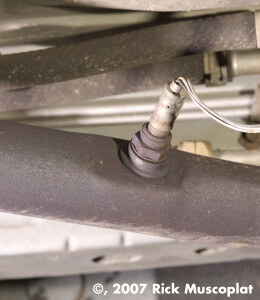P0133 Code — What it means and the most common causes
Learn what a P0133 code means, the most common causes and how to fix it
A P0133 code is defined as: 02 Sensor Circuit Slow Response (Bank 1 Sensor 1). Bank 1 is the bank that holds cylinder #1 and sensor 1 is the sensor upstream from the catalytic
converter. The code means that the upstream oxygen sensor on the exhaust from bank 1 isn’t reacting as quickly as it should to changing oxygen levels.
The ECM is constantly updating the air/fuel mixture and overshooting and undershooting the 14.7:1 ratio. It expects the oxygen sensor to respond to the resulting rich/lean conditions caused by the under and over-shooting. In fact, a good oxygen sensor must see and report the switching at least 8 times per second. A P0133 means it does not meet that criteria and is known as a “lazy sensor.”
How the ECM tests the oxygen sensor
The engine computer waits until the engine has reached at least 145 degrees, and the vehicle has driven at least 10-MPH for 30 seconds before it starts looking at the switching rate. The computer looks for about 8 voltage changes per second (these are called CROSS COUNTS). If it sees less than that, it sets this code, telling you that you have a “lazy sensor.”
Oxygen sensors wear out between 80,000-100,000 miles. But they can also be damaged by coolant, silicone, and engine misfires. If you have this code, chances are your Oxygen sensor needs to be replaced.
The most common causes of a P0133 code
Bad oxygen sensor: A faulty or contaminated oxygen sensor is one of the most common causes of the P0133 code. If the sensor is dirty, contaminated, or malfunctioning, it can’t send the correct information to the ECM. Even though many internet articles claim you can clean a contaminated oxygen sensor, it’s actually impossible to do so. See this article on why you can’t clean a contaminated oxygen sensor. If you get this code, don’t automatically assume the sensor is bad because a vacuum leak or exhaust leak can cause the oxygen sensor to be wacky.
Exhaust leak: An exhaust leak can cause the P0133 code to appear. If there is a leak in the exhaust system, it can allow unmetered air to enter the engine, causing the air-fuel mixture to become lean and cause irregular oxygen sensor readings.
Vacuum leak: Vacuum leaks can cause the P0133 code to appear. Just like an exhaust leak, a vacuum leak can mess up the oxygen sensor readings and cause this code.
How to diagnose a P0133 code
It’s really difficult for a DIYer to check the operation of an oxygen sensor without a scope. So you have to approach this from a process of elimination. First, eliminate the possibility of an exhaust or vacuum leak. Disconnect the electrical connector to the oxygen sensor and check for corrosion. If all that checks out, then you can feel confident replacing the oxygen sensor.
Symptoms of a P0133 code
Poor fuel economy
Poor acceleration
Hesitation
© 2012 Rick Muscoplat
Posted on by Rick Muscoplat

